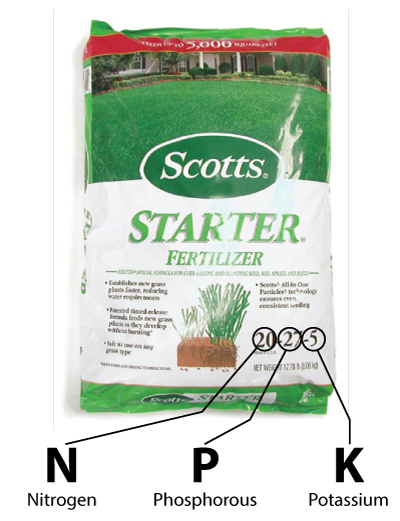Teacher Guide Sections
Introduction to Chemistry and Energy Efficiency
Insulation
Fertilizer and Crop Production
Lighting
Polymers
Suggested Reading: Fertilizer and Crop Production
Activity One: Reading Fertilizer Labels
Objective
Students will be able to calculate the components of a bag of fertilizer and compare the nutrients.Time
One class periodMaterials
-Internet Access-Physical or online pictures of fertilizer bags that show the fertilizer grades. A sample image can be found below.

Procedure
- Have students learn how to calculate the components of a bag of fertilizer using the web site: http://www.ncagr.gov/cyber/kidswrld/plant/label.htm
- After students understand the fertilizer grade and its components, give each pair a picture, or have them find their own picture of fertilizer bags. Students then calculate the nutrient content of the bag of fertilizer.
- Students should save their nutrient content information for the next activity.
Activity Two: Testing Soil for Fertilizer Application
Objective
Students learn about the soil nutrients in their local environment.Time
Two class periods, may be spread out over time depending on whether you send your soil samples out for testing or conduct the tests in your classroom.Materials
-Soil samplesPreparation
- Call your local office of the Natural Resources Conservation Service (NRDC) and see if they will analyze soil samples for your class. You can locate your local NRDC office using the U.S. Department of Agriculture web site: http://offices.sc.egov.usda.gov/locator/app
- Another alternative is to purchase a soil sample kit so your students can test the soil themselves. Many different options are available on-line. One example is eNasco’s Soil Test Kit available for $13.35. This kit has enough equipment to test the pH, nitrogen, potash, and phosphorus for 10 soil samples. You can order online at www.enasco.com.
Procedure
- Discuss with students how to collect a soil sample. Information about collecting soil samples can be found at: http://www.ncagr.gov/cyber/kidswrld/plant/soiltest.htm
- Have students collect a soil sample, submit it for testing, or test it themselves.
- Students should analyze the results of their tests and select an appropriate fertilizer given the results.